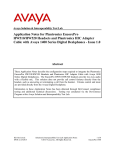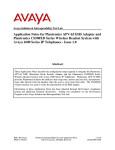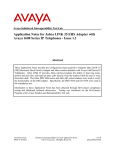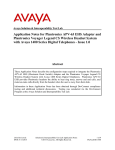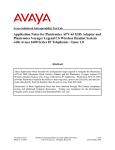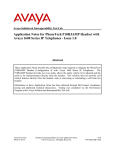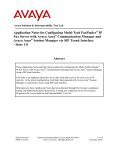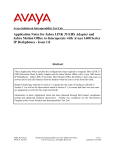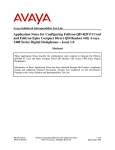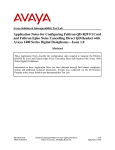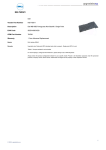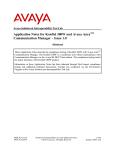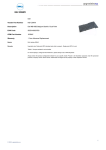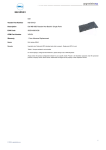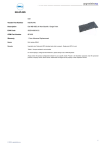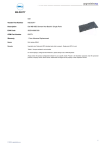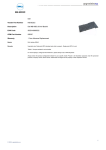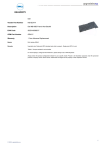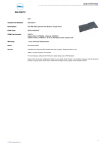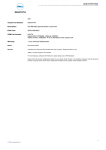Download Avaya 1400 Series Digital Telephones Application Note
Transcript
Avaya Solution & Interoperability Test Lab Application Notes for Plantronics APV-63 EHS Adapter and Plantronics CS500 Series Wireless Headset System with Avaya 1400 Series Digital Telephones - Issue 1.0 Abstract These Application Notes describe the configuration steps required to integrate the Plantronics APV-63 EHS (Electronic Hook Switch) Adapter and the Plantronics CS500 Series Wireless Headset System with Avaya 1400 Series Digital Telephones. Plantronics APV-63 EHS provides Plantronics headsets the ability to hear ring tones, answer and end calls, and mute/unmute calls directly from the headset when the user is away from their desk. The CS540 wireless headset was used to verify the functionality of the EHS adapter. Information in these Application Notes has been obtained through DevConnect compliance testing and additional technical discussions. Testing was conducted via the DevConnect Program at the Avaya Solution and Interoperability Test Lab. JAO; Reviewed: SPOC 9/4/2012 Solution & Interoperability Test Lab Application Notes ©2012 Avaya Inc. All Rights Reserved. 1 of 9 PlantAPV63-1400 1. Introduction These Application Notes describe the configuration steps required to integrate the Plantronics APV-63 EHS (Electronic Hook Switch) Adapter and the Plantronics CS500 Series Wireless Headset System with Avaya 1400 Series Digital Telephones. Plantronics APV-63 EHS provides Plantronics headsets the ability to hear ring tones, answer and end calls, and mute/un-mute calls directly from the headset when the user is away from their desk. The CS540 wireless headset was used to verify the functionality of the EHS adapter. 2. General Test Approach and Test Results DevConnect Compliance Testing is conducted jointly by Avaya and DevConnect members. The jointly-defined test plan focuses on exercising APIs and/or standards-based interfaces pertinent to the interoperability of the tested products and their functionalities. DevConnect Compliance Testing is not intended to substitute full product performance or feature testing performed by DevConnect members, nor is it to be construed as an endorsement by Avaya of the suitability or completeness of a DevConnect member’s solution. Avaya’s formal testing and Declaration of Conformity is provided only on the headsets/handsets that carry the Avaya brand or logo. Avaya may conduct testing of non-Avaya headset/handset to determine interoperability with Avaya phones. However, Avaya does not conduct the testing of non-Avaya headsets/handsets for: Acoustic Pressure, Safety, Hearing Aid Compliance, EMC regulations, or any other tests to ensure conformity with safety, audio quality, long-term reliability or any regulation requirements. As a result, Avaya makes no representations whether a particular non-Avaya headset will work with Avaya’s telephones or with a different generation of the same Avaya telephone. Since there is no industry standard for handset interfaces, different manufacturers utilize different handset/headset interfaces with their telephones. Therefore, any claim made by a headset vendor that its product is compatible with Avaya telephones does not equate to a guarantee that the headset will provide adequate safety protection or audio quality. The interoperability compliance test included feature and serviceability testing. The feature testing focused on placing calls to and from the Avaya 1400 Series Digital Telephones with the Plantronics APV-63 EHS Adapter and Plantronics CS540 wireless headset and verifying twoway audio. The call types included calls to voicemail, to local extensions, and to the PSTN. The serviceability testing focused on verifying the usability of the Plantronics wireless headset after restarting the Avaya 1400 Series Digital Telephones. JAO; Reviewed: SPOC 9/4/2012 Solution & Interoperability Test Lab Application Notes ©2012 Avaya Inc. All Rights Reserved. 2 of 9 PlantAPV63-1400 2.1. Interoperability Compliance Testing All test cases were performed manually. The following features were verified: Placing calls to the voicemail system. Voice messages were recorded and played back to verify that the playback volume and recording level were good. Placing calls to internal extensions to verify two-way audio. Placing calls to the PSTN to verify two-way audio. Hearing ring back tone for incoming and outgoing calls. Answering and ending calls using the call control button on the headset. Using the volume control buttons on the Plantronics headset to adjust the audio volume. Using the mute control button on the Plantronics headset to mute and un-mute the audio. For the serviceability testing, an Avaya 1408 Digital Telephone was restarted to verify proper operation of the headset after the reboot was completed. 2.2. Test Results All test cases passed. See Section 3.1 for instructions on answering, ending, and placing calls with the headset. 2.3. Support For technical support and information on Plantronics APV-63 EHS Adapter and Plantronics CS500 Series Wireless Headset System, contact Plantronics at: Phone: 800-544-4660 (toll free) +1 831-426-5858 (International) Website: http://www.plantronics.com/north_america/en_US/support/ JAO; Reviewed: SPOC 9/4/2012 Solution & Interoperability Test Lab Application Notes ©2012 Avaya Inc. All Rights Reserved. 3 of 9 PlantAPV63-1400 3. Reference Configuration Figure 1 illustrates the test configuration used to verify the Plantronics APV-63 EHS Adapter and Plantronics CS540 Wireless Headset System with Avaya 1400 Series Digital Telephones. The configuration consists of an Avaya S8300 Server running Avaya Aura® Communication Manager with an Avaya G450 Media Gateway providing connectivity to the PSTN via an ISDNPRI trunk (not shown). Avaya Aura® Messaging was used as the voicemail system. Avaya Aura® Messaging LAN Avaya Aura® Communication Manager running on Avaya S8300 Server with G450 Media Gateway Avaya 9600 Series IP Telephones Avaya 1408 Digital Telephone with Plantronics APV-63 EHS Adapter and Plantronics CS540 Wireless Headset System Figure 1: Avaya 1400 Series Digital Telephone with Plantronics APV-63 EHS Adapter and Plantronics CS540 Wireless Headset System JAO; Reviewed: SPOC 9/4/2012 Solution & Interoperability Test Lab Application Notes ©2012 Avaya Inc. All Rights Reserved. 4 of 9 PlantAPV63-1400 3.1. Answering, Ending, and Placing Calls To answer, end, or place a call using the Plantronics headset follow the instructions below. To Answer a Call Press the call control button on the headset to answer an incoming call. This would automatically activate the headset button on the digital telephone. Alternatively, if the headset button on the digital telephone is pressed first, then press the call control button on the headset, if it isn’t already activated, to answer an incoming call. Note that pressing the headset button on the digital telephone does not automatically activate the call control button on the headset. To End a Call If auto-answer is enabled and the headset button on the digital telephone and the call control button on the headset are activated, subsequent incoming calls will be answered automatically and a twoway audio path will be established to the headset. Press the call control button on the headset to terminate a call. This automatically deactivates the headset button on the digital telephone. Alternatively, if the call is terminated by pressing the headset button on the digital telephone, the call control button on the headset remains activated. Note that pressing the headset button on the digital telephone does not automatically deactivate the call control button on the headset. To Place a Call Press the call control button on the headset to get dial tone and dial the number. This would automatically activate the headset button on the digital telephone. Alternatively, if the headset button on the digital telephone is pressed first, the call control button on the headset needs to be pressed manually. Pressing the headset button on the digital telephone does not automatically activate the call control button on the headset. JAO; Reviewed: SPOC 9/4/2012 Solution & Interoperability Test Lab Application Notes ©2012 Avaya Inc. All Rights Reserved. 5 of 9 PlantAPV63-1400 4. Equipment and Software Validated The following equipment and software were used for the sample configuration provided: Equipment/Software Release/Version Avaya Aura® Communication Manager running Avaya S8300D Server with a G450 Media Gateway 6.0.1 SP 5.01 (R016x.00.1.510.1 w/Patch 19303) Avaya Aura® Messaging 6.0.1 SP 1 Avaya 1400 Series Digital Telephones -- Avaya 9600 Series IP Telephones 3.1 SP 4 (H.323) Plantronics APV-63 EHS Adapter P/N 38734-11 Plantronics CS540 Wireless Headset System -- JAO; Reviewed: SPOC 9/4/2012 Solution & Interoperability Test Lab Application Notes ©2012 Avaya Inc. All Rights Reserved. 6 of 9 PlantAPV63-1400 5. Configure Avaya Aura® Communication Manager This section covers the station configuration for the Avaya 1408 Digital Telephone. The configuration is performed via the System Access Terminal (SAT) on Communication Manager. 5.1. Configure a Station for Avaya 1400 Series Digital Telephone Use the add station command to create a station for the 1408 Digital telephone. Set the Type field to the station type to be emulated. In this example, 1408 was used. Set the Port field to the appropriate digital port.. Note: To enable Auto Answer on the digital telephone set the Auto Answer field on Page 2 (not shown) to the appropriate value, such as all. add station 40010 Page 1 of 5 STATION Extension: Type: Port: Name: 40010 1408 001V301 Plantronics Lock Messages? n Security Code: Coverage Path 1: Coverage Path 2: Hunt-to Station: BCC: TN: COR: COS: 0 1 1 1 STATION OPTIONS Loss Group: 2 Speakerphone: 2-way Display Language: english Survivable COR: internal Survivable Trunk Dest? y JAO; Reviewed: SPOC 9/4/2012 Time of Day Lock Table: Personalized Ringing Pattern: 1 Message Lamp Ext: 40010 Mute Button Enabled? y IP SoftPhone? n Remote Office Phone: n IP Video? n Solution & Interoperability Test Lab Application Notes ©2012 Avaya Inc. All Rights Reserved. 7 of 9 PlantAPV63-1400 6. Configure Plantronics APV-63 EHS and Plantronics CS540 Wireless Headset System To connect the CS540 wireless headset to the Avaya 1400 Series Digital Telephone, use the APV-63 EHS adapter to connect the wireless base of the headset to the headset port of the 1408 digital telephone. All other default settings on the wireless base were used. Note: No external ring detect cable is required for the headset to hear incoming call notification (i.e., beeps). 7. Verification Steps Verify that the Plantronics APV-63 EHS and Plantronics CS540 have been connected to the Avaya 1400 Series Digital Telephone. Once the headset is connected to the phone, verify that incoming and outgoing calls are established with two-way audio to the headset and that the headset can get dial tone and end an active call. 8. Conclusion These Application Notes describe the configuration steps required to integrate the Plantronics APV-63 EHS Adapter and Plantronics CS500 Series Wireless Headset System with Avaya 1400 Series Digital Telephones. All test cases were completed successfully with observations noted in Section 2.2. 9. Additional References This section references the Avaya and Plantronics documentation that are relevant to these Application Notes. The following Avaya product documentation can be found at http://support.avaya.com. [1] Administering Avaya Aura™ Communication Manager, Release 6.0, Issue 6.0, June 2010, Document Number 03-300509. [2] Avaya 1400 Series Digital Deskphones User Guide for Avaya Aura® Communication Manager, Issue 3, March 2011, Document Number 16-603151. [3] Avaya one-X® Deskphone Edition for 9600 Series IP Telephones Installation and Maintenance Guide, Release 3.1, Issue 7, November 2009, Document Number 16-300694. The following Plantronics documentation can be found at http://www.plantronics.com. [4] Plantronics APV-63 EHS Adapter Quick Reference Guide. [5] Plantronics CS540 Wireless Headset System Quick Start Guide. JAO; Reviewed: SPOC 9/4/2012 Solution & Interoperability Test Lab Application Notes ©2012 Avaya Inc. All Rights Reserved. 8 of 9 PlantAPV63-1400 ©2012 Avaya Inc. All Rights Reserved. Avaya and the Avaya Logo are trademarks of Avaya Inc. All trademarks identified by ® and ™ are registered trademarks or trademarks, respectively, of Avaya Inc. All other trademarks are the property of their respective owners. The information provided in these Application Notes is subject to change without notice. The configurations, technical data, and recommendations provided in these Application Notes are believed to be accurate and dependable, but are presented without express or implied warranty. Users are responsible for their application of any products specified in these Application Notes. Please e-mail any questions or comments pertaining to these Application Notes along with the full title name and filename, located in the lower right corner, directly to the Avaya DevConnect Program at [email protected]. JAO; Reviewed: SPOC 9/4/2012 Solution & Interoperability Test Lab Application Notes ©2012 Avaya Inc. All Rights Reserved. 9 of 9 PlantAPV63-1400










